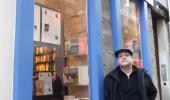Scorsese's 3-D 'Hugo' a visual tour de force
Leave it to Martin Scorsese to redeem the wretched excess of 3-D. Unlike James Cameron's "Avatar," "Hugo" is not a bloated 3-D spectacle. It is, rather, the first movie to integrate the spectacular 3-D device naturally into the telling of a beautiful story.
It must be nice to be Mr. Scorsese at this point in his legendary career -- to be able to do what you want. And it's correspondingly nice to be his audience.
What Mr. Scorsese wants nowadays in general -- with "Hugo" in particular -- is to celebrate the history and magic of film itself. He found a perfect vehicle to do so in author-artist Brian Selznick's 2007 book, "The Invention of Hugo Cabret," whose elaborately detailed illustrations served as a ready-made storyboard for the film.
The adventure is set in 1931 Paris, where our 12-year-old hero Hugo (Asa Butterfield) lives clandestinely in the walls of a vast train station. He's a plucky orphan whose late father (Jude Law) was a horologist. Hugo inherited his dad's passion for clocks and the job of tending to the huge timepieces of the Gare Montparnasse.
He is living a secret life in a public place -- high up in the clockworks. There, he tinkers with his father's inventions and tries to solve the mystery of a broken "automaton" robot -- when he's not eluding the Station Inspector (Sacha Baron Cohen) or stealing spare parts from an old toy-stall owner.
That would be Georges Melies (Ben Kingsley), pioneer inventor of fantastic science fiction in the cinema but long since bitter and forgotten. The old codger's goddaughter Isabelle (Chloe Grace Moretz) becomes Hugo's plucky girl-sidekick in the boy's quest for cinemagical answers.
The real-life Melies made an astonishing 500 short films between 1896 and 1913, including the fabulous "Voyage to the Moon," but he went broke during World War I, when the French Army seized most of his films, melted them down and turned the liquid into soldiers' boot heels. "Hugo" is Mr. Scorsese's homage to him and other founding film fathers.
"Hugo's" set design and Robert Richardson's cinematography are inspired, from the gorgeous opening of Paris vistas to the last frame. Mr. Scorsese shoots from a low-angled child's viewpoint and employs 3-D's mega effects sparingly for the action sequences, in which Hugo is chased through treacherously narrow spaces, down tunnels, along passageways and up stairways to the aerie from which he and we peer out to a glistening storybook vision of Paris.
But Mr. Scorsese also uses 3-D for the simple natural phenomena of snowflakes, floating dust particles, and fish in a forefront aquarium -- and to augment such humorous details as the Station Inspector's huge gimpy foot in a sling. The backgrounds are as deliberately artificial as those in children's books -- and as those in Melies' incredibly fanciful early films, where nymphs hang from stars and the Man in the Moon melts from the impact of a spaceship.
Clips of Chaplin, Keaton, Harold Lloyd and the sainted Louise Brooks ornament the visual journey, while Howard Shore's terrific original music scores it, using such period French instruments as the ondes Martenot (an early electronic keyboard) and the musette (a French accordion) -- with salient snatches of Erik Satie.
Androgynous young Butterfield is fine, if not charismatic, in his title role, while Mr. Cohen -- better known as Borat! -- is hilarious as Hugo's seriocomic nemesis. The explication scenes between Hugo, Isabelle and a late-appearing film historian are more talky and didactic than they really need to be. But the story's emotional and historical resonance are spot-on: A love of film brings a film-loving boy and an unloved filmmaker to intertwined real and reel life.
Exquisitely crafted "Hugo" may be a bit long for little kids, but its images are wholly enchanting, especially its tour de force montage ending, in which state-of-the-art 1898 meets state-of-the-art 2012 F/X.
THAT, rather than elongated blue people, is truly spectacular magic.






